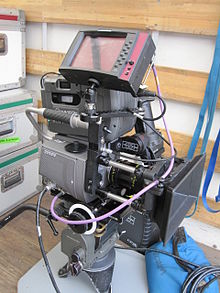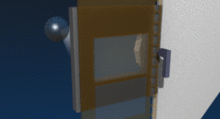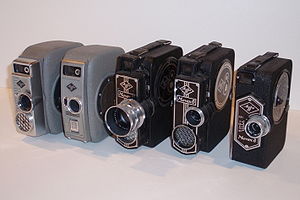- Movie camera
-
- This article is about motion picture film cameras. See video camera for cameras which record images electronically.
The movie camera is a type of photographic camera which takes a rapid sequence of photographs on strips of film which was very popular for private use in the last century until its successor, the video camera, replaced it. Many of these cameras today have become collectors items and there is a small but well organized group of fans of these devices who still use and maintain these cameras as hobby or a special interest, even if they went out of productions a long time ago. For professional purposes however, movie cameras are used and produced today, especially for the production of full feature movies. In contrast to a still camera, which captures a single snapshot at a time, the movie camera takes a series of images; "frame". This is accomplished through an intermittent mechanism. The frames are later played back in a movie projector at a specific speed, called the "frame rate" (number of frames per second). While viewing, a person's eyes and brain merge the separate pictures together to create the illusion of motion.[1]
Contents
History
One of the first motion-picture film cameras was designed by Louis Le Prince in 1888. It still exists with the National Media Museum, England. Le Prince employed paper bands and celluloid film from John Carbutt and or Blair & Eastman in 1¾ inch width. The first motion picture camera that actually worked was created by Thomas Alva Edison.
On June 21 1889, William Friese-Greene was issued patent no. 10131 for his 'chronophotographic' camera. It was apparently capable of taking up to ten photographs per second using perforated celluloid film. A report on the camera was published in the British Photographic News on February 28 1890. On 18 March, Friese-Greene sent a clipping of the story.[2] Friese-Greene gave a public demonstration in 1890 but the low frame rate combined with the device's apparent unreliability failed to make an impression.
Georges Demenÿ, employee with Etienne Jules Marey, constructed the Beater Movement in 1893. The film width is 60 mm.
Max Skladanowsky conceived his own make of camera in 1894-95, but more interesting is his “Bioscop” projector, the first duplex construction in practice. Green, part designer for Prestwich, also designed a duplex projecting machine. This 1896 wide-film projector can be seen at the South Kensington Science Museum.
The Lumière Domitor camera was originated by Charles Moisson, chief mechanic of the Lumière works at Lyon in 1894. They shot on paper film of 35 millimeter width. In 1895 the Lumière could buy celluloïd film from New-York’s Celluloid Manufacturing Co. This they covered with their own Etiquette-bleue emulsion, had it cut into strips and perforated. It is not known which recipe they used for positives.
Then an ever increasing number of cine cameras came up. The makes and brands would be: Birt Acres (1894-95), the Latham Eidoloscope by Lauste (1895), the Marvin & Casler Bioscope by Dickson (1895), Pathé frères (1896) with ratchet claws, Prestwich (1896), Newman & Guardia (1896), de Bedts, Gaumont-Démény (1896), Schneider, Schimpf, Akeley, Debrie, Bell & Howell, Leonard-Mitchell, Ertel, Ernemann, Eclair, Stachow, Universal, Institute, Wall, Lytax, and many others.
The first all-metal cine camera is the Bell & Howell Standard of 1911-12. One of the most complicated models is the Mitchell-Technicolor Beam Splitting Three-Strip Camera of 1932. With it, three colour separation originals are obtained behind a purple, a green, and a red light filter, the latter being part of one of the three different raw materials in use.
The most popular 35 mm cameras in use today are Arriflex, Moviecam (now owned by the Arri Group), and Panavision models. For very high speed filming, PhotoSonics are used.
Technical details
Most of the optical and mechanical elements of a movie camera are present in the movie projector. The requirements for film tensioning, take-up, intermittent motion, loops, and rack positioning are almost identical. The camera will not have an illumination source and will maintain its film stock in a light-tight enclosure. A camera will also have exposure control via an iris aperture located on the lens. Also, there is a rotating, sometimes mirrored shutter behind the lens, which alternately passes the light from the lens to the film, or reflects it into the viewfinder. The righthand side of the camera is often referred to by camera assistants as "the dumb side" because it usually lacks indicators or readouts and access to the film threading, as well as lens markings on many lens models. More recent equipment often has done much to minimize these shortcomings, although access to the film movement block by both sides is precluded by basic motor and electronic design necessities.
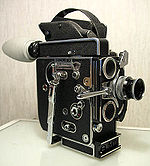 A spring-wound Bolex 16 mm camera
A spring-wound Bolex 16 mm camera
The standardized frame rate for commercial sound film is 24 frames per second. The standard commercial (i.e., movie-theater film) width is 35 millimeters, while many other film formats exist. The standard aspect ratios are 1.66, 1.85, and 2.39 (anamorphic). NTSC video (common in North America and Japan) plays at 29.97 frame/s; PAL (common in most other countries) plays at 25 frame/s. These two television and video systems also have different resolutions and color encodings. Many of the technical difficulties involving film and video concern translation between the different formats. Video aspect ratios are 4:3 (1.33) for full screen and 16:9 (1.78) for widescreen.
Multiple cameras
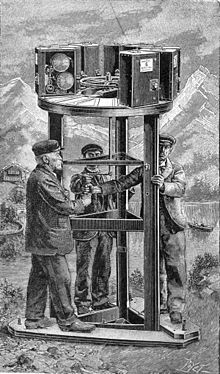 Multiple cameras to take surround images (1900 Cinéorama system, for modern version see Circle-Vision 360°
Multiple cameras to take surround images (1900 Cinéorama system, for modern version see Circle-Vision 360°
Multiple-camera setups may be used and synchronized. Both of the films is projected simultaneously, either on a single three-image screen (Cinerama) or upon multiple screens forming a complete circle, with gaps between screens through which the projectors illuminate an opposite screen. (See Circle-Vision 360°) convex and concave mirrors are used in cameras as well as mirrors.
Sound synchronization
One of continuing problems in film is synchronizing a sound recording with the film. Most film cameras do not record sound internally; instead, the sound is captured separately by a precision audio device (see double-system recording). The exceptions to this are the single-system news film cameras, which had either an optical—or later—magnetic recording head inside the camera. For optical recording, the film only had a single perforation and the area where the other set of perforations would have been was exposed to a controlled bright light that would burn a waveform image that would later regulate the passage of light and playback the sound. For magnetic recording, that same area of the single perf 16 mm film that was prestriped with a magnetic stripe. A smaller balance stripe existed between the perforations and the edge to compensate the thickness of the recording stripe to keep the film wound evenly.
Double-system cameras are generally categorized as either "sync" or "non-sync." Sync cameras use crystal-controlled motors that ensure that film is advanced through the camera at a precise speed. In addition, they're designed to be quiet enough to not hamper sound recording of the scene being shot. Non-sync or "MOS" cameras do not offer these features; any attempt to match location sound to these cameras' footage will eventually result in "sync drift", and the noise they emit typically renders location sound recording useless.
To synchronize double-system footage, the clapper board which typically starts a take is used as a reference point for the editor to match the picture to the sound (provided the scene and take are also called out so that the editor knows which picture take goes with any given sound take). It also permits scene and take numbers and other essential information to be seen on the film itself. Aaton cameras have a system called AatonCode that can "jam sync" with a timecode-based audio recorder and prints a digital timecode directly on the edge of the film itself. However, the most commonly used system at the moment is unique identifier numbers exposed on the edge of the film by the film stock manufacturer (KeyKode is the name for Kodak's system). These are then logged (usually by a computer editing system, but sometimes by hand) and recorded along with audio timecode during editing. In the case of no better alternative, a handclap can work if done clearly and properly, but often a quick tap on the microphone (provided it is in frame for this gesture) is preferred.
One of the most common uses of non-sync cameras are the spring-wound cameras used in hazardous special effects, known as "crash cams". Scenes shot with these have to be kept short, or resynchronized manually with the sound. MOS cameras are also often used for second unit work or anything involving slow or fast-motion filming.
Home movie cameras
Movie cameras were available before World War II often using the 9.5 mm film format. The use of movie cameras had an upsurge in popularity in the immediate post-war period giving rise to the creation of home movies. Compared to the pre-war models, these cameras were small, light, fairly sophisticated and affordable. An extremely compact 35 mm movie camera Kinamo was designed by Emanuel Goldberg for amateur and semi-professional movies in 1921. A spring motor attachment was added in 1923 to allow flexible handheld filming. The Kinamo was used by Joris Ivens and other avant-garde and documentary filmmakers in the late 1920s and early 1930s.[3][4]
While a basic model might have a single fixed aperture/focus lens, a better version might have three or four lenses of differing apertures and focal lengths on a rotating turret. A good quality camera might come with a variety of interchangeable, focusable lenses or possibly a single zoom lens. The viewfinder was normally a parallel sight within or on top of the camera body. In the 1950s and for much of the 1960s these cameras were powered by clockwork motors, again with variations of quality. A simple mechanism might only power the camera for some 30 seconds, while a geared drive camera might work for as long as 75 - 90 seconds (at standard speeds). Even today there is a market among collectors for these types of camera, as the engineering and materials were of a very high standard and no battery is required. While film stock and the ability to process it exists, these cameras can still be used.
The common film used for these cameras was termed Standard 8, which was a strip of 16 millimetre wide film which was only exposed down one half during shooting. The film had twice the number of perforations as film for 16 mm cameras and so the frames were half as high and half as wide as 16 mm frames. The film was removed and placed back in the camera to expose the frames on the other side once the first half had been exposed. Once the film was developed it was sliced down the middle and the ends attached, giving 50-foot (15 m) of Standard 8 film from a spool of 25-foot (7.6 m) of 16 mm film. 16 mm cameras, mechanically similar to the smaller format models, were also used in home movie making but were more usually the tools of semi professional film and news film makers.
In the 1960s a new film format, Super8, coincided with the advent of battery operated electric movie cameras. The new film, with a larger frame print on the same width of film stock, came in a cassette which simplified changeover and developing. Another advantage of the new system is that they had the capacity to record sound, albeit of indifferent quality. Camera bodies, and sometimes lenses, were increasingly made in plastic rather than the metals of the earlier types. As the costs of mass production came down, so did the price and these cameras became very popular. This type of format and camera was more quickly superseded for amateurs by the advent of video cameras, although some professionals continued to make use of its visual characteristics alongside larger format film and video cameras.
References
- ^ Joseph and Barbara Anderson, "The Myth of Persistence of Vision Revisited," Journal of Film and Video, Vol. 45, No. 1 (Spring 1993): 3-12. http://www.uca.edu/org/ccsmi/ccsmi/classicwork/Myth%20Revisited.htm
- ^ Braun, Marta, Picturing Time: The Work of Etienne-Jules Marey (1830–1904) (Chicago: University of Chicago Press, 1992/ISBN 0-226-07173-1), p. 190; Robinson, David, From Peepshow to Palace: The Birth of American Film (New York and Chichester, West Sussex: Columbia University Press, 1997/ISBN 0-231-10338-7), p. 28.
- ^ Buckland, Michael. The Kinamo camera, Emanuel Goldberg, and Joris Ivens. In: Film History 20 (1) (2008): 49-58. http://muse.jhu.edu/journals/film_history/v020/20.1.buckland.pdf
- ^ Ica and the Kinamo and Joris Evens. In: Buckland, Michael: Emanuel Goldberg and his Knowledge Machine. Libraries Unlimited, 2006. ISBN 0-313-31332-6. pp. 85-92 and pp. 92-95
See also
Categories:- Film and video technology
- Cameras by type
- Movie cameras
Wikimedia Foundation. 2010.

